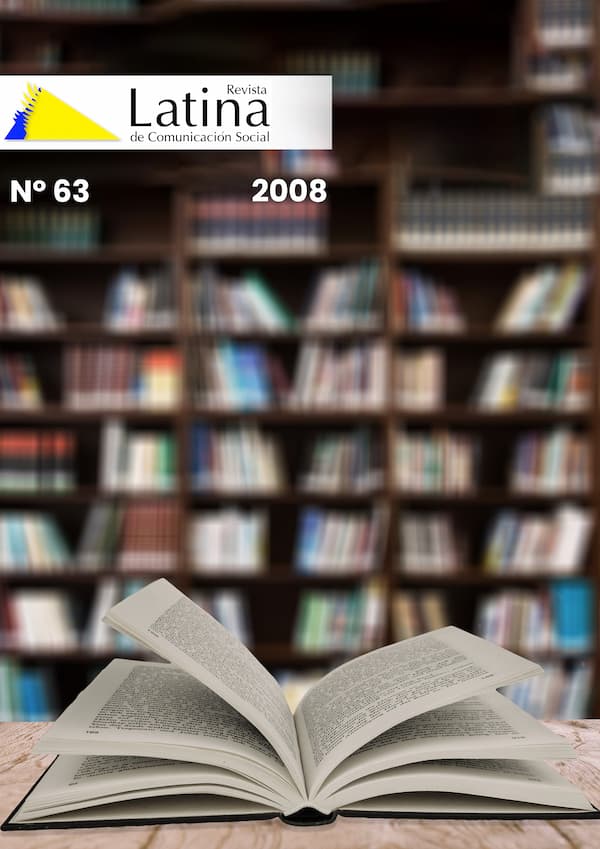La anticipación del sonido y su relación con la estructura narrativa del mensaje audiovisual
DOI:
https://doi.org/10.4185/RLCS-63-2008-790-400-408Palabras clave:
overlapping, Sincronía, Montaje, Edición, Postproducción, Realización, Vídeo, Estimulación, Percepción, Atención, Codificación, Comprensión, Memoria, Mensaje, Complejidad, Procesamiento, Información, Coherencia, Expresión, Eficacia, Emoción, Lenguaje, Gramática, Plano, Escena, SecuenciaResumen
El retraso del sonido respecto de la imagen (overlapping) constituye un recurso expresivo del montaje audiovisual utilizado frecuentemente por los realizadores para remarcar el ingreso de una acción nueva o relevante en el desarrollo de las historias. Sin embargo, no existen estudios empíricos que avalen el efecto directamente asociado a este procedimiento en los discursos. En el presente artículo se efectúa un estudio cualitativo mediante el cual se analiza una muestra de 235 overlappings de secuencias de películas, noticias y anuncios de publicidad, registrados de vídeos de Internet. Se advierte un tratamiento fílmico propio del overlapping, la existencia de una estructura semántica coherente que define este tipo de mensajes y una eventual relación entre los cambios de la intensidad del sonido con efectos emocionales como la sorpresa. Los resultados obtenidos pueden ser útiles para desarrollar un método de análisis y mejora de la efectividad de los discursos audiovisuales basados en la estimulación perceptiva, y para el diseño de sistemas eficientes de postproducción de video y sonido.
Descargas
Citas
Amiel, V. (2005): Estética del montaje. Madrid, Abada.
Benedetti, R. (2004): Creative postproduction: editing, sound, visual effects, and music for film and video. Boston: Pearson Education.
Browne, S. E. (2003): Edición de vídeo. Madrid, IORTV.
Dancyger, K. (1999): Técnicas de edición de vídeo y cine. Barcelona, Gedisa.
Del Rey, P. (2002): Montaje. una profesión de cine. Barcelona, Ariel.
D' Ydewalle, G. & Germeys, F. (2005): "The psychology of film: perceiving beyond the cut". Psychological Research, Oct 8; 1-9
Fox, J. & et al. (2005): Effects of positive and negative content on attention and memory of pop-up advertisements. Conference papers International Communication Association, Annual Meeting, New York, NY, p. 1-5.
Fox, J. (2004): "A signal detection analysis of audio/video redundancy effects in television news video". Communication Research, 31(5), pp. 524-536. DOI: https://doi.org/10.1177/0093650204267931
Lang, A. (2000): "The limited capacity model of mediated message processing". Journal of Communication, 50(1), 46-70. DOI: https://doi.org/10.1111/j.1460-2466.2000.tb02833.x
Lang, A. (1999): "The Effects of Production Pacing and Arousing Content on the Information Processing of Television Messages". Journal of Broadcasting & Electronic Media, 43. DOI: https://doi.org/10.1080/08838159909364504
Lang, A. (1995): "Defining Audio/Video Redundancy From a Limited-Capacity Information Processing Perspective". Communication Research, 22(1), 86-115. DOI: https://doi.org/10.1177/009365095022001004
Mitry, J. (2002): Estética y psicología del cine. Madrid, Siglo XXI. Reisz, K. &.
Ohman, A. (1997): "As fast as the blink of an eye: Evolutionary preparedness for preatentive processing of threat". In Lang, P. J., Simons, R. F. & Balaban, M. (Eds.), Atention and orienting: Sensory and motivational processes (pp.165–184). Hilsdale, NJ: Erlbaum.1997
Morales, F. (2001): Teoría y práctica de la edición en video. Lima, Perú, Edit. USMP.
Reisz, K. & Millar, G. (2003): Técnica del montaje cinematográfico. Madrid, Plot.
Rey del Val, P. (2002): Montaje. una profesión de cine, Madrid, Ariel.
Rodríguez, A. (2003): "La investigación aplicada: una nueva perspectiva para los estudios de la recepción", Anàlisi: Quaderns de comunicació i cultura, 30, 17-36.
Rodríguez, A. (1998): La dimensión sonora del lenguaje audiovisual. Barcelona, Paidós.
Zhou, S. (2005): "Effects of arousing visuals and redundancy on cognitive assessment of television news". Journal of Broadcasting & Electronic Media. DOI: https://doi.org/10.1207/s15506878jobem4901_3
Publicado
Cómo citar
Número
Sección
Licencia
Derechos de autor 2022 Luis Fernando Morales Morante

Esta obra está bajo una licencia internacional Creative Commons Atribución-NoComercial-SinDerivadas 4.0.








